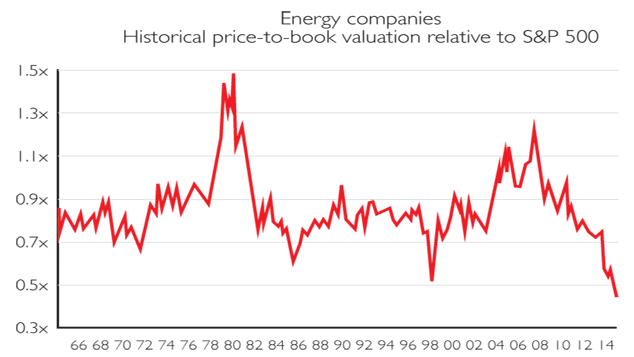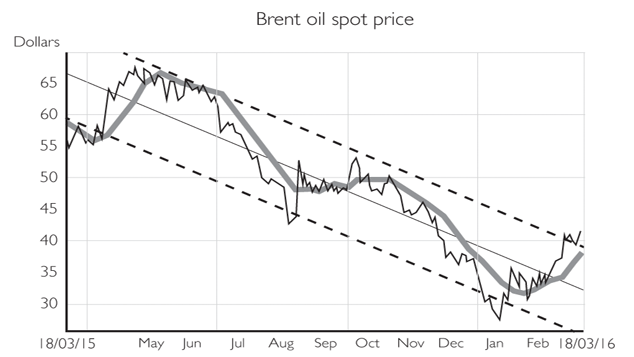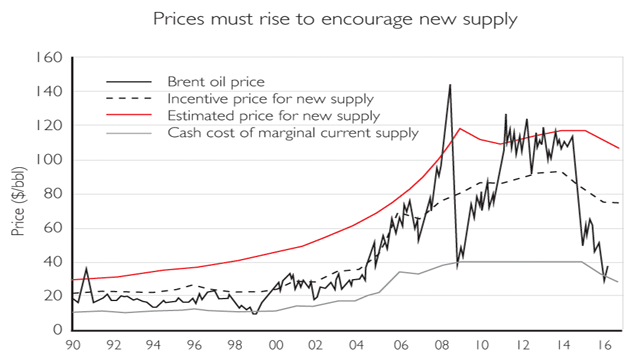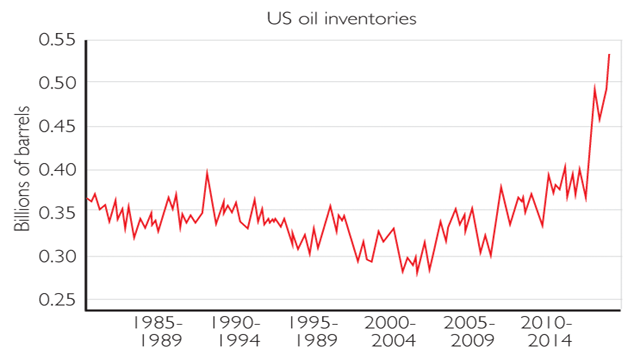The bulls inch ahead in the oil stakes
The oil price has probably bottomed, says David C Stevenson. Investors need to tread carefully and be patient, but this could be a good time to start buying energy stocks.


The oil price has probably bottomed, says David C Stevenson. Investors need to tread carefullyand be patient, but this could be a good time to start buying energy stocks.
In recent years, I've had a slightly ambivalent relationship with the resources sector, and energy stocks in particular. On the one hand, I love the idea of buying into the producers of the key strategic resources that we'll need over the next two decades, and of making money from the profound transformation in energy infrastructure that the big Western economies require.
On the other hand, my cynical side thinks that resources prices went too high and as a result companies got carried away drilling wells and digging mines in all sorts of places, letting costs run out of control, and frittering away hundreds of billions of dollars in the process.
MoneyWeek
Subscribe to MoneyWeek today and get your first six magazine issues absolutely FREE

Sign up to Money Morning
Don't miss the latest investment and personal finances news, market analysis, plus money-saving tips with our free twice-daily newsletter
Don't miss the latest investment and personal finances news, market analysis, plus money-saving tips with our free twice-daily newsletter
Capitalism is brilliant at getting tightfisted money men and women to blow their investors' cash on providing a great public good in ever greater quantities. The price of this good then collapses due to excess supply, destroying the value of their businesses. The trigger for this bizarre form of philanthrophy is usually technological change: for example, in this case, technology made it easier to tap hard-to-reach oil reserves, and the outcome was an oil glut. That's great for energy consumers, but bad for Saudi Arabia and other producers and for those who invested in the sector during the boom.
Yet with energy prices now at multi-year lows, I'm debating my stance all over again. Have prices bottomed out? Are valuations at rock-bottom? Is this the investment opportunity of the decade, or is it just a value trap, luring us in before prices fall even lower?
The bull case
It certainly isn't easy to find an answer to any of these questions, but let's start by asking how the debate is playing out at the macro level. On the side of the oil bulls, there are a few very convincing arguments. Take equity valuations first.
The energy sector is trading at a price-to-book-value ratio that is less than half that of the overall S&P 500, according to Guinness Asset Management, a specialist in the energy sector. This is more than two standard deviations below the long-term average in other words, the sector very rarely gets this cheap compared to the wider market. Similar "oversold" conditions in 1986 and 1998 represented good buying opportunities. The first chart from Guinness shows this clearly.

As for the oil price itself, the last few weeks have also brought better news. Both Brent and West Texas Intermediate (WTI) crude oil prices have picked up sharply. The second chart shows the price for Brent crude oil over the last year. The thick grey line is the 20-day moving average and I've put trend (dotted) lines at either side of the main price line. Notice how prices have surged beyond the 20-day moving average and are now threatening to push past the key trend line both bullish signs.

In fact, the S&P GSCI Crude Oil index posted a massive three-day gain of 14.4% back in mid-February. This was the biggest three-day gain in about six months for the index, according to S&P's analysts, and gains of this magnitude have usually only happened when the oil price is near a bottom.
The energy bulls argue that perhaps the Saudis are close to achieving their objective of bankrupting lots of American oil firms by flooding the market and keeping prices low. Some analysts reckon there could be as many as 200 bankruptcies in the sector over the coming year. Fewer than 25% of US explorers and producers are delivering positive earnings per share, according to Guinness, and 300,000 people have lost their jobs.
The asset manager reckons that US production is likely to fall by around 10% in 2017, partly as a result of huge capital expenditure cuts (investment is down by 70% from 2014 levels). Countries not in the Opec cartel and outside America are faring even worse, as they face higher break-even costs and had already started cutting investment when prices fell to $100 per barrel.
The next chart spells out the horrible truth facing most oil producers: prices are way below any sensible profit levels, and in most cases only a tad above cash costs. In sum, the bulls argue that the adjustment phase has begun and we're probably midway through a painful restructuring process.

Over to the bears
So that's the bull case. What about the bears? Well, they have plenty of good points too. Analysts at Goldman Sachs are sticking with their grim view on energy markets, for example. They concede that some measures look positive guidance from non-Opec producers is finally pointing to supply declines in 2016, which should be bullish for prices. However, they argue that if prices head back above $40 a barrel, the adjustment process which requires a massive cut in output will be shelved, simply delaying the inevitable process of market capitulation.
Goldman's analysts are especially worried about vast amounts of oil sitting around in mid-Western US storage tanks, which are setting new highs (see chart below). So they reckon that the market will remain oversupplied in coming months, and the result will be that prices stay in a volatile range, roughly between $25 to $45.
Saudis remain the key players
There's certainly a risk that energy bulls are being hopelessly naive in thinking the worst is past. One can make the case that oil prices need to fall below $20 a barrel, for example. At those levels, we'd see carnage in the sector. Nonetheless, a trading range of $25 to $45 seems to be about right for the prime movers in this drama the Saudis. Maybe their strategy is more subtle than investors imagine. Perhaps sustained low prices for three years would suit them better than a sharp plunge.
If that's the case and on balance, it's what I expect then maybe now is the time to think about putting a bit more money to work in the energy sector. However, this is highly uncertain and I'd advise extreme caution. I'd only ever suggest a very slow drip-feeding of money back into certain energy funds over the next three to six months. And I'd still add an important caveat or two. Firstly, oil prices could easily fall from current levels; and secondly, you may not see a profit for at least another year or so.
If you're going to invest, the next question is which funds to focus on. You could invest in an exchange-traded product that directly tracks the oil price, but I think this is a fool's errand these instruments are best for traders and speculators, not investors. It makes more sense to consider investing in a basket of energy stocks, either through an active fund or a tracker.
An innovative choice
If you favour an active fund, there's a very small number of fund managers who specialise in this area. They include the Artemis Global Energy Fund (packed full of cheap oil majors, including ExxonMobil, Royal Dutch Shell and Total, plus the odd explorer), the small SF Fundamental Energy Fund (which invests in specialist oil-equipment businesses) and Guinness Global Energy. The latter is well-established and fairly innovative in that its 30 core holdings are given equal weight in the portfolio. That makes it look very different from those in a fund such as the Artemis one, which is dominated by its mega-cap holdings. On balance, for an active fund, I'd go with Guinness.
There's much more choice among passive exchange-traded funds (ETFs), with most major ETF firms offering at least one dedicated energy-sector product. Your first decision is which index you want to track. First, there's the MSCI World Energy index a good catch-all index that tracks the biggest global energy businesses. One obvious candidate for tracking this is the db x-trackers MSCI World Energy ETF (LSE: XWED).
Alternatively, you could choose to focus on European energy firms only (such as Royal Dutch Shell, BP and Total), through the MSCI Europe Energy index. One option for tracking this is the SPDR MSCI Europe Energy ETF (LSE: ENGY). If you'd prefer to invest in US-listed firms such as Exxon, Chevron and oil-services firm Schlumberger, you could use an S&P 500 sector tracker, such as the iShares S&P 500 Energy Sector ETF (LSE: IESU).
Of these, I would probably favour the big global sector indices, but other investors may have a preference for the European companies over the American ones, or vice versa, depending on your view of how attractive their relative valuations and prospects are. However, my preferred way to invest in the sector at the moment is to opt for more defensive, conservative funds that track energy transport and storage firms in the US mostly master limited partnerships (MLPs), which pay generous dividends. Choices here include the ETFS US Energy Infrastructure MLP GO ETF (LSE: MLPX) and the Source Morningstar US Energy Infrastructure MLP ETF (LSE: MLPS).
Why oil keeps me awake at night

My first recommendation after taking over as the editor of The Fleet Street Letter in January was to buy oil stocks, writes Charlie Morris. The price had fallen below $30 per barrel, yet a number of indicators suggested the fall had gone too far. There was excessive speculation by short-sellers and a "contango" had developed in the market, meaning that the spot price (oil for immediate delivery) was significantly below the forward price (oil for delivery in the future). Similar signals in 1994, 1998 and 2008 marked the low following those oil bear markets.
With prices at or below $30, producers are in trouble, so sustained low prices ought to lead to a fall in supply. There may be a surplus today, but that's unlikely to remain the case indefinitely. The world needs oil, and for long-term supplies to be guaranteed vast amounts of capital investment are required. That investment will only happen with prices above $60. In January, these arguments suggested that there would be a floor at $30, while prices should recover to $60 inthe medium term in order to return the market to more stable equilibrium. So I told readers to buy oil stocks.
Two months on, and of all the trades that I've recommended in The Fleet Street Letter so far, this is the one that keeps me awake. It's been a good trade (oil rose 50% between mid-January and mid-March), but supply remains strong while demand growth is slack. The combination of a slowing economy and improved energy efficiencies has failed to tighten the market and reduce supply. The excess oil has had to go somewhere and the result has been rising inventories, as you can see in the chart.

The last time inventories were this high was in 1990 the time of the first Gulf War. Following the early price spike, the oil market didn't tighten properly until around 2003, when growth in China took the market by surprise.
I'm sticking with the view that $30 is a problem for the industry and $60 is the target to secure future supplies. If oilfirms made low returns at $100, thenwhat now? The banks won't be keento support small, struggling producers indefinitely and are putting pressure onthem. Still, this trade makes me nervous,because it could take a long time forthe situation to be resolved. The biggerenergy firms aren't looking like steelcompanies yet, but if this persists, theymight be asking for state support too.
Charlie Morris is the editor of The FleetStreet Letter.
Get the latest financial news, insights and expert analysis from our award-winning MoneyWeek team, to help you understand what really matters when it comes to your finances.

David Stevenson has been writing the Financial Times Adventurous Investor column for nearly 15 years and is also a regular columnist for Citywire.
He writes his own widely read Adventurous Investor SubStack newsletter at davidstevenson.substack.com
David has also had a successful career as a media entrepreneur setting up the big European fintech news and event outfit www.altfi.com as well as www.etfstream.com in the asset management space.
Before that, he was a founding partner in the Rocket Science Group, a successful corporate comms business.
David has also written a number of books on investing, funds, ETFs, and stock picking and is currently a non-executive director on a number of stockmarket-listed funds including Gresham House Energy Storage and the Aurora Investment Trust.
In what remains of his spare time he is a presiding justice on the Southampton magistrates bench.
-
 The shape of yields to come
The shape of yields to comeCentral banks are likely to buy up short-term bonds to keep debt costs down for governments
-
 The sad decline of investment clubs – and what comes next
The sad decline of investment clubs – and what comes nextOpinion Financial regulation and rising costs are killing off investment clubs that once used to be an enjoyable hobby, says David Prosser